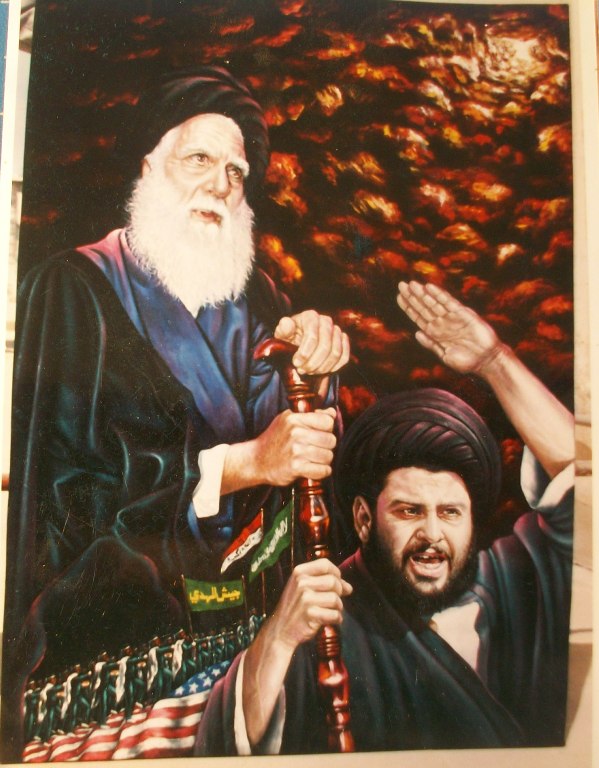These are a grouping of pictures captured in Iraq. As you can tell, these are pictures of Muqtada-al-Sadr and his father Grand Ayatollah Mohammad Mohammad Sadeq al-Sadr. Both individuals claim a direct lineage back to the Prophet Muhammad.
Sadeq al-Sadr and two of his sons were murdered on February 19, 1999 and this act was thought to have been perpurtrated by the Baath Party and Saddam Hussein.
Sadeq-al-Sadr was a very popular and very influential Shi'a leader in Iraq. Following the fall of Baghdad, the majority-Shi'a suburb of Revolution City (Saddam City) was unofficially but popularly renamed to Sadr City in his honor. Sadr City was the first part of Baghdad to overthrow the Baath Party in 2003.
After the fall of the Saddam government in 2003, Muqtada al-Sadr organized thousands of his supporters into a political movement, which includes a military wing known as the Jaysh al-Mahdi or Mahdi Army. His strongest support comes from the class of dispossessed Shi‘a, like in the Sadr City area of Baghdad. Many Iraqi supporters see in him a symbol of resistance to foreign occupation.
Muqtada al-Sadr is currently the leader of the Sadr-ist movement and bases his legitimacy upon his relationship to his father. He led a guerilla uprising against Coalition forces and the new Iraqi government as part of the Iraqi Insurgency between 2004 to 2008.
Muqtada-al-Sadr link: http://en.wikipedia.org/wiki/Muqtada_al-Sadr
Mohammad Mohammad Sadeq al-Sadr link: http://en.wikipedia.org/wiki/Mohammad_Mohammad_Sadeq_al-Sadr
Mahdi Army link: http://en.wikipedia.org/wiki/Mahdi_Army

Sadeq al-Sadr and two of his sons were murdered on February 19, 1999 and this act was thought to have been perpurtrated by the Baath Party and Saddam Hussein.
Sadeq-al-Sadr was a very popular and very influential Shi'a leader in Iraq. Following the fall of Baghdad, the majority-Shi'a suburb of Revolution City (Saddam City) was unofficially but popularly renamed to Sadr City in his honor. Sadr City was the first part of Baghdad to overthrow the Baath Party in 2003.
After the fall of the Saddam government in 2003, Muqtada al-Sadr organized thousands of his supporters into a political movement, which includes a military wing known as the Jaysh al-Mahdi or Mahdi Army. His strongest support comes from the class of dispossessed Shi‘a, like in the Sadr City area of Baghdad. Many Iraqi supporters see in him a symbol of resistance to foreign occupation.
Muqtada al-Sadr is currently the leader of the Sadr-ist movement and bases his legitimacy upon his relationship to his father. He led a guerilla uprising against Coalition forces and the new Iraqi government as part of the Iraqi Insurgency between 2004 to 2008.
Muqtada-al-Sadr link: http://en.wikipedia.org/wiki/Muqtada_al-Sadr
Mohammad Mohammad Sadeq al-Sadr link: http://en.wikipedia.org/wiki/Mohammad_Mohammad_Sadeq_al-Sadr
Mahdi Army link: http://en.wikipedia.org/wiki/Mahdi_Army










